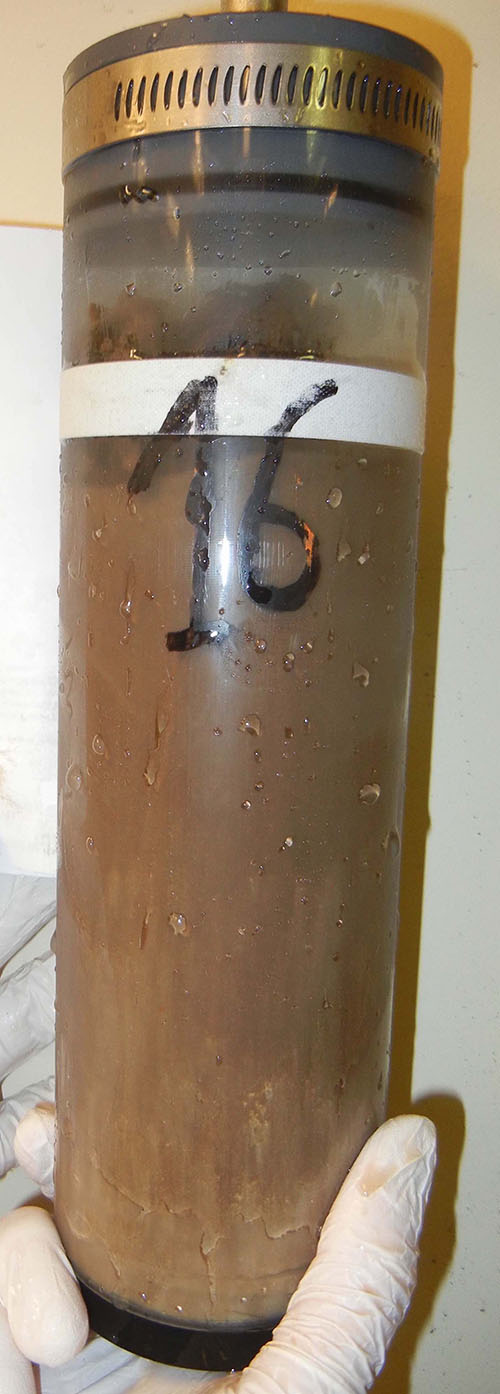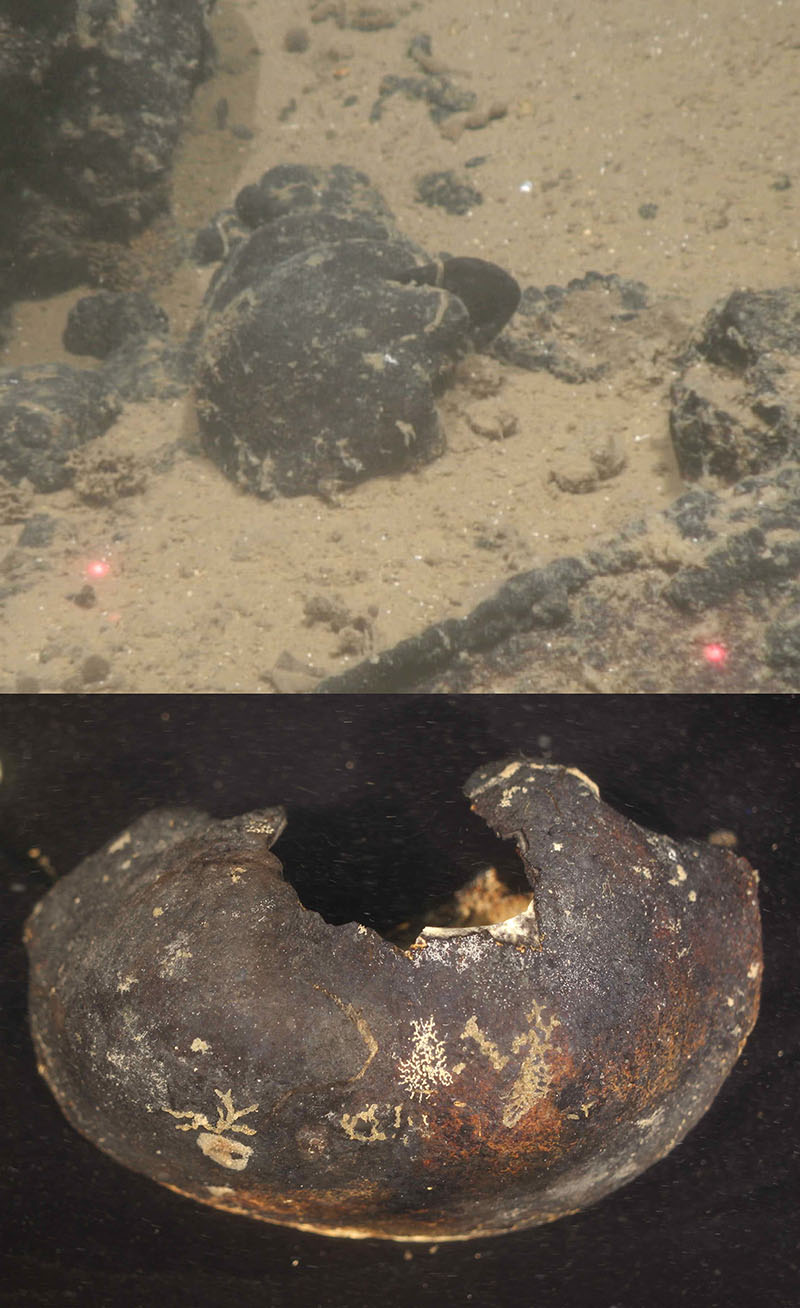
By Regan Drennan, Research Assistant, Natural History Museum, London
June 15, 2018
A league under the sea, a glass tulip grows in pitch darkness and absolute silence. It shines crystal white as a dazzling light descends on it, a mechanical claw reaching out to dexterously pluck it from the seafloor without crushing its fine glass lattice. The delicate process of collecting a glass sponge with the remotely operated vehicle (ROV) feels strangely akin to picking a flower, albeit using a ton of hulking high-tech machinery controlled from five kilometers above by a team of people working in unison.

A stalked glass sponge (Class: Hexactinellida) “growing” on the abyssal plain of APEI 4. The latticework skeleton of a glass sponge is siliceous, i.e. made of glass. The distance between the two laser points is 15 centimeters. Image courtesy of the DeepCCZ expedition. Download larger version (jpg, 606 KB).
This has been my first time working on a research cruise, and there have been several such moments that have truly made me stop in my tracks and appreciate the perspective of the scales that deep-sea research works at, and the near-inconceivably bizarre, beautiful, and science-fiction like world that it entails—far more so than I have experienced from just reading scientific papers. Perhaps my most brain-grinding-to-a-halt, mind-blowing moment was not from something as poetic as glass sponge picking, but rather in an on-board laboratory, slicing sediment cores.
On each dive, the ROV takes several seven-centimeter-wide cores of sediment from the seafloor. At the surface, these cores are sliced into layers that correspond with different depths, from the first half centimeter, down through varying centimeter intervals to the bottom of the core; the upper slices are runny whilst the deeper slices are thick and solid, and come out looking like freestanding cylinders of chocolate mousse. These slices can then be analyzed for a plethora of things, such as microbes, environmental DNA, grain size, organic carbon content, and various biomarkers, which can vary with the depth of sediment. Often, manganese nodules or certain fauna, such as burrowing anemones, can also be collected in cores, which are brought to the surface as they were found on the seafloor.

A sediment core, collected from the seafloor using the ROV. With such slow rates of sedimentation on the abyssal plains of the CCZ, this core could represent thousands and thousands of years of deposition. Image courtesy of the DeepCCZ expedition. Download larger version (jpg, 1.2 MB).
A large volume of useful and telling data comes out of these cores, though the slicing part is not a glamorous process, indeed not one you want to wear your best clothes to. I had previously heard that the rates of sedimentation on the abyssal plains of the Clarion-Clipperton Zone (CCZ) were incredibly slow. This rate can vary across the region, but can be only a few millimeters per thousand years, that is, a few millimeters of mud added to the seafloor every millennium. It was not until someone re-iterated this fact, mid-slice, with muck all over my gloves, clothes, and possibly hair, that it truly hit me: in just these 15 centimeters of mud, there could be about 50,000 years worth of sediment—so much of human history encapsulated in the upper few layers that we were just unceremoniously slicing and sliding into sterile sample bags! Perhaps, when a Palaeolithic human was smearing the likeness of an animal on a cave wall, a tiny mote of sediment, now smeared on my wrist, was silently settling at the bottom of the ocean. For a nanosecond, I recoiled and panicked—we shouldn’t be touching this, it’s too old, too precious! Of course, I was being silly and sentimental over inanimate mud—I think that we humans have a tendency to romanticise and revere ancient things, perhaps as our own time here is so relatively brief, though perhaps I am getting carried away with taking too much philosophical meaning from mud.
I suppose that the age of something on this planet is a relative thing, based on what stage of a various material cycle it is at (rock, carbon, water, life, etc.). What covered our gloves was simply en route from sediment to sedimentary rock, before we rudely undid millions of years of settling by the core-full, bringing it back to square one—though perhaps this time it will have better luck and settle somewhere with a speedier sedimentation rate. In these abyssal plains, time moves so slowly that even geological time elsewhere can appear faster in comparison. Even its weird and wonderful creatures often have much slower growth rates compared with their shallow water counterparts. The black potato-sized manganese nodules, a major research interest of this cruise, grow slower still—in fact their growth is amongst the slowest of all geological phenomena, with rates of manganese accretion of less than half a centimeter every million years.

Manganese nodules: at the size of large potatoes, these are tens of millions of years old. Image courtesy of the DeepCCZ expedition. Download larger version (jpg, 1 MB).
Another example of the molasses-like pace of the CCZ became eerily clear during the end of an ROV descent, as we approached the seabed. What appeared to be a mess of jagged coal-black rock jutting out from the pale silt turned out on closer inspection to be the skull of a small whale. Glued to the camera displays at the surface, we couldn’t tell if the remains of this creature were thousands or millions of years old—but they were old. A manganese crust, which accretes in same slow process that forms the nodules, coated and encrusted the bones, which, despite all that time, still lay on the surface where they landed. Here, it is not uncommon to find the remains of beasts from prehistory, as if they fell yesterday (though with a blackened encasing crust). Even massive megalodon teeth (megaladon: the primeval whale-sized, whale-eating shark of legend and childhood fantasy) have been seen casually sitting on the sediment surface, cocooned in manganese. A combination of the slow sedimentation rate, and some other not-fully-understood-yet forces, keep nodules, bones, and other heavy things at the top of the sediment, unsinking. Like flies stuck in amber, these ancient remains are stuck in the slow flow of deep-sea time. It is as if we are given an intimate view into the past, similar to seeing the ash-frozen bodies at Pompeii.

Upper: the manganese-encrusted ear bone of a whale amongst a small whale skull before it is sampled by the ROV. The distance between the two lasers is 15 centimeters. Lower: that same ear bone, photographed in the lab. The ear bones of whales can be used to identify species, even for extinct specimens. There is a possibility that ancient DNA still exists within the bone tissue, preserved in the cold stable conditions of the abyssal plain, and protected by the manganese crust. Image courtesy of the DeepCCZ expedition. Download larger version (jpg, 2.6 MB).
All of this starkly puts into perspective how difficult it is for this land of frozen time to recover from environmental disturbance. If nodule mining were to be undertaken here, immense plumes of mud and silt would slowly spread out for miles, hanging in the water column like an ominous raincloud and slowly settling to the bottom, smothering fauna that lie beneath as it does so. Nodules, providing anchors and homes to a range of diverse fauna types, once removed, would take tens of millions of years to regrow. For us of the terrestrial plane, where re-establishing a forest could take a lifetime or two, the recovery of these abyssal habitats is unimaginably long. These environments are so poorly understood, so little explored, that we could destroy this unique and alien world before we get a chance to truly study its mysteries.
As the cruise comes to an end and the process of wading through and analysing the collected data begins, it will be very exciting to see what kind of light our results may shed on our understanding of the CCZ and hopefully contribute vital information to conservation efforts, so that in thousands of years, glass flowers may still grow in the gloom.